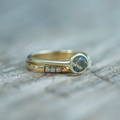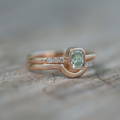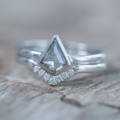Your Cart is Empty
11 Ring Stacking Secrets Nobody Tells You About
(but we will)
The Ultimate Non-Boring Guide to Bridal ring Stacks
Congratulations! You've got the engagement ring, you've said yes, and now you're thinking about what comes next: your bridal stack.
(Because one ring is great, but have you tried three?)
Picking out your bridal stack might just be the most exciting part of wedding planning. (Sorry, cake tastings.)
There's something magical about imagining how your engagement ring will look paired with your wedding band - and maybe an anniversary ring down the line?
And the whole "engagement ring + plain wedding band" combo?
That's just one option in a world of possibilities.
Some of our brides stack three thin bands. Others rock a single statement piece. A few brave souls have even mixed their mom's vintage band with a modern sapphire ring and somehow made it work spectacularly.
Because contrary to what the entire wedding industry wants you to believe, there's more to life than a plain band next to your engagement ring.
Your ring stack is going to be on your hand every day. It should make you smile, not stress. Don't let anyone tell you there's only one way to do it.
So first up: let's demolish some myths.
Here's the thing: most ring stacking advice is either super vague ("just follow your heart!") or weirdly strict ("the wedding band must go first").
After helping countless couples create their perfect stacks, we're here to give you actual, concrete tips that'll help you create a stack you'll love wearing for years to come. Not just for pretty photos, but for everyday life where you need to, you know, use your hands.
So here are 11 things about stacking rings that actually matter (aka things no one tells you but should):
1. THe height factor
Before we dive into all the pretty stuff, let's talk about something super practical: how high your rings sit on your finger.
Because as boring as it may sound, height matters. A lot. And it’s a bigger deal than anyone admits. That gorgeous 5-carat stunner sitting sky-high on your finger? The one with the cathedral setting that makes your diamond look like it's floating? It's beautiful.
But before you commit, let's talk about what happens when you add a wedding band or two.
You're wearing these rings every day. That gorgeous-but-scratchy setting? It's going to drive you nuts by day three. Think about:
- How high your rings sit (catching on everything is not the vibe)
- The way they feel between your fingers (awkward spacing = constant fidgeting)
- Whether they spin around (so annoying during important hand gestures)
Here's what nobody warns you about ring height:
- Anything over 7mm total height becomes a sweater snagger
- High settings create shadows (and sometimes gaps) with other rings
- The higher your engagement ring sits, the more likely your stack is to spin

Some specific heights to consider:
- <4mm: Low profile for everyday wear.
- 4-6mm: Sweet spot for most stacks. You still get the pretty profile, but your rings actually stay where they're supposed to.
- 6-7mm: Still wearable, but starting to get tall
- 7mm+: It's going to catch on every sweater you own. And your hair. And probably your partner's eye during enthusiastic hand-talking.
So if you're stacking multiple rings, think about their combined height. Unless catching your ring on everything is your idea of a good time.
2. Size matters too
(we’re talking about width).
Most engagement rings are between 1.8mm and 2.5mm wide. This is your baseline.
Look at the profile (that's the side view) of your ring. Does it sit high? Low? Are there details on the sides that you'd want to show? All of this affects how other rings will sit next to it.
Here's a common stack killer: rings that are all the same width.
The secret to a stack that works? Variety. But not random variety - intentional contrast that creates visual interest.
A stack of three 2mm bands might sound perfect on paper, but in reality it can look a bit... underwhelming. Not because thin bands aren't beautiful (they are!), but because having everything the same width doesn't give your eyes anywhere interesting to look at.
Here's something we've learned after years of ring stacking:
- Thin + thin + thin = elegant, but might get lost
- Wide + wide = might look chunky (unless that's what you're after)
- Thin + medium + thin = usually just right
Here's what actually works:
- Start with your engagement ring width. Let's say it's 1.8 mm.
- Your wedding band could go slightly wider (2.5-3.5 mm). This subtle difference creates interest without looking messy.
- Want to add a third ring? Try something that matches either your engagement ring or wedding band width.
Some of our favorite width combinations:
- 1.8 mm engagement ring + 2.5 mm wedding band + 1.8 mm anniversary ring
- 1.8 mm engagement ring + 3.5 mm statement wedding band

3. Ring space and gaps

Let's talk about something that'll drive you nuts once you notice it: gaps between rings.
Some people LOVE them (hello, statement makers) - they're all about that negative space life. Others would rather eat glass than see daylight between their rings. Both are fine! But you need to decide which camp you're in before you commit.
Some stacks sit perfectly flush together. Others have tiny gaps. Both can work beautifully, but they create completely different looks. So the real question isn't whether gaps are good or bad - it's whether you love it every time you look down at your hand.
What to consider:
- Flush stacks feel more cohesive
- Small gaps can create interesting shadow play
- Your ring's setting height affects how other rings sit next to it
Pro tip: If you're wearing multiple rings, they'll naturally create tiny spaces as they move on your finger. This isn't a flaw - it's part of how your stack lives with you.
4. The Great Metal Debate

Remember when mixing metals was considered a fashion faux pas? Yeah, we're done with that.
Rose gold with white gold? Go for it. Yellow gold engagement ring with a platinum band? If it makes you happy, do it.
3 tips:
- Pick a dominant metal for your main piece (usually your engagement ring)
- Use contrasting metals intentionally - make it look like you meant to do that
- Think about how metals age - some get darker, some get lighter, some stay pretty much the same
And, pro tip: If you're mixing metals, consider getting them all in the same karat. If you get rings with different gold content, the rings will scratch and damage each other.
5. The Stone situation
Let's talk about stones. Big ones, small ones, some as big as your... budget allows.
When you're stacking rings with stones, graduating sizes are your friend. Think of it like a tiny crystal skyline on your finger. Start with your largest stone (usually the engagement ring) and work your way down. Or don't. Sometimes a rebel small stone in the mix makes things interesting.
But here's what no one tells you about stones in stacks:
- Not every ring needs them (seriously, it's okay to have plain bands)
- Mixing stone shapes can look AMAZING or absolutely terrible (there's no in-between)
- Color matching is optional but coordination is key
- Some stones are tougher than others (looking at you, opal)
6. Consider the stone shapes
Remember when round diamonds were basically mandatory? Those days are gone, and now we're seeing the most incredible combinations of stone shapes in stacks.
But here's something we've learned after years of creating stacks: certain shapes play better together than others.
An oval engagement ring stone, for instance, looks amazing with curved bands that follow its shape. A hexagon-cut sapphire? It practically begs for geometric wedding bands that echo its angles.

Round stones: The easiest to stack with. Almost anything works.

Oval and cushion cuts: Loves curved bands that follow its shape

Hexagon, kite and geometric cuts: Needs straight bands or angular designs

Pear and marquise cuts: Looks amazing with v-shaped or curved bands
What actually makes stone shapes work together:
- Similar lines: If your engagement stone is all curves, stick with curved accents
- Complementary angles: Geometric stones love geometric friends
- Proportional sizes: A tiny round diamond next to a massive pear shape might feel unbalanced
Specific combinations we love:
- Oval center stone + curved bands with small round accents
- Hexagon sapphire + straight bands with geometric details
- Round center stone + literally anything (it's the universal donor of stone shapes)
Your engagement ring’s stone is the centerpiece. Stack rings and gemstones that complement, rather than overwhelm, its shape. A classic round diamond loves the company of a delicate pavé band, while a bold hexagon cut green sapphire pairs well with a nesting band with light blue, teal or green gemstone accents.
7. Add a Pop of Color
Fun fact: some of our favorite stacks started because someone dared to add a colored stone to their stack. And no, we're not just talking about subtle champagne diamonds (though those are gorgeous too).
The best part about adding color to your stack? You can go as bold or subtle as you want. A soft green sapphire nestled between white diamond bands creates just a whisper of color. A bright ruby next to rose gold? Now that's a statement.
Adding color to your stack? Here's how to do it right:
- Keep one metal consistent throughout
- Use neutral stones (like white diamonds) as buffers between colored gems
- Stick to a color family (all cool tones or all warm tones)
Some color combinations that never fail:
- Montana sapphires with white diamonds (the blue-green plays beautifully with the sparkle)
- Pink sapphires with rose gold (warm and feminine without being too sweet)
- Salt and pepper diamonds with any colored stone and yellow gold (the contrast is chef's kiss)
Pro tip: If you're nervous about adding color, start with something in the same color family as your metal. Yellow sapphires in yellow gold, for instance, create depth without screaming "look at me!"
8. Go asymmetric

Here's something that might sound scary but actually works amazingly well: your stack doesn't need to match perfectly on both sides of your engagement ring. Asymmetry can make your stack look intentionally artistic.
We're not talking about total chaos - just thoughtful imbalance. Maybe a wider band on one side, a thinner one on the other. Or two dainty rings on the left, one statement piece on the right.
Offset bands with unique shapes or add a geometric ring for a little edge.
Why this works:
- It creates natural movement for your eye
- Each ring gets to shine without competing
- You can add pieces over time without worrying about perfect symmetry
Real examples we love:
- 2mm engagement ring + 2.5mm textured band on one side + 1.8mm plain band on the other
- Solitaire ring + curved band on one side + straight band with tiny diamonds on the other
9. The Little Details That Make It Special

Sometimes it's the things nobody else can see that make a stack special. A tiny diamond hidden on the inside of your band. Your wedding date engraved in a spot only you know about. Your partner's initials tucked away under a setting.
These secret details don't have to be obvious or expensive:
- Engraving can be as simple as a date or as complex as a fingerprint
- Hidden stones can be tiny and still meaningful
- Even the profile (side view) of your rings can hide special details
10. The Reality Check
(Because Someone Has To Say It)
Your rings WILL scratch each other. It's not a maybe, it's a when. Even the hardest metals will show wear over time.
And while we're being real:
- Your fingers will change size (thanks, weather/hormones/that extra slice of pizza)
- Some days you'll want to wear the whole stack, others just one ring
- What looks good in photos might feel terrible in real life
Making It Work IRL (In Real Life, not just on Pinterest)
Your Lifestyle Matters
If you're constantly washing your hands (hello, healthcare workers), working with tools, or typing all day, consider:
- How high can your rings safely be?
- Do you need to take them off often?
- Are you okay with maintenance, or do you need something bulletproof?
11. Building a Stack That Grows with You
Your stack is about to become a tiny timeline of your love story. That engagement ring? That's chapter one. Your wedding band might be inspired by where you first met, or have the coordinates of your ceremony spot secretly engraved inside.
And it only gets better from there. We've created stacks that include everything from sapphires matching the color of where he proposed to hidden diamonds marking the birth of a child. (And yes, some people really do add a new ring for every major milestone - we're looking at you, Sarah, with your gorgeous five-ring stack!)
The best part? Your stack grows with you. No need to figure it all out right now. Start with what makes your heart happy today, and leave room for tomorrow's adventures.
Each ring can mark something special: the proposal, the wedding day, your first anniversary. We've created engagement rings with sapphires that match where he proposed, wedding bands with secret engravings, and anniversary rings that celebrate the birth of a child.
The beauty of building a meaningful stack is that it grows with you. Maybe you start with that perfect engagement ring, add a wedding band that complements it perfectly, then leave room for future pieces that celebrate milestones along the way.
Some of our favorite meaningful combinations:
- Engagement rings with birthstones instead of diamonds
- Wedding bands with coordinates engraved inside
- Anniversary rings that match the color of your baby's birthstone
What we’re saying is: think about future additions. Anniversary bands. Push presents. "Just because" rings. (They're a thing, trust us.)
Leave room for your stack to grow. Or don't, and start a new stack on another finger. We won't judge.
How to plan ahead:
- Consider how new rings might fit with your current ones
- Think about milestone rings you might want to add
- Keep track of your ring specs (width, metal, size) for future additions
The Mini Stack Strategy Guide
- Start with your engagement ring (obviously). This is your foundation. Everything else needs to play nice with it.
- Think about your wedding band next. Do you want it to:
- Sit flush (no gaps)
- Curve around your engagement ring
- Stand alone but complement
- Make a statement of its own
- Consider future additions. Maybe you want to sandwich your engagement ring between two matching bands. Or add accent rings for anniversaries.
Pro Stack Configurations That Actually Work:
The Classic Plus
- Engagement ring
- Simple wedding band
- One accent band
- Total: 3 rings, endless possibilities
The Minimalist
- Engagement ring
- Thin wedding band
- Total: 2 rings
The Maximalist
- Engagement ring
- Two wedding bands (one on each side)
- Anniversary band
- Total: 4 rings, maximum impact
And remember: if you hate it later, you can always change it up. That's the beauty of a stack - it's not set in stone. (had to slip one bad pun in here.)
Bottom Line
After all these tips, here's what really matters:
- Comfort trumps everything (because you're wearing these every day)
- Start with quality pieces (they'll last longer and wear better)
- Think about how you actually live and work
Our actual, professional advice after years of helping people stack rings?
Start simple. You can always add more later.
Because at the end of the day, the only person who has to love your stack is you. (And maybe your partner, but they probably just want you to be happy anyway.)
Ready to start stacking? Check out our collection of rings that play well with others. And if you need help figuring out what works together, just ask. We've seen it all - from the perfectly planned to the "this shouldn't work but somehow does" combinations.
Let's make something awesome together!











